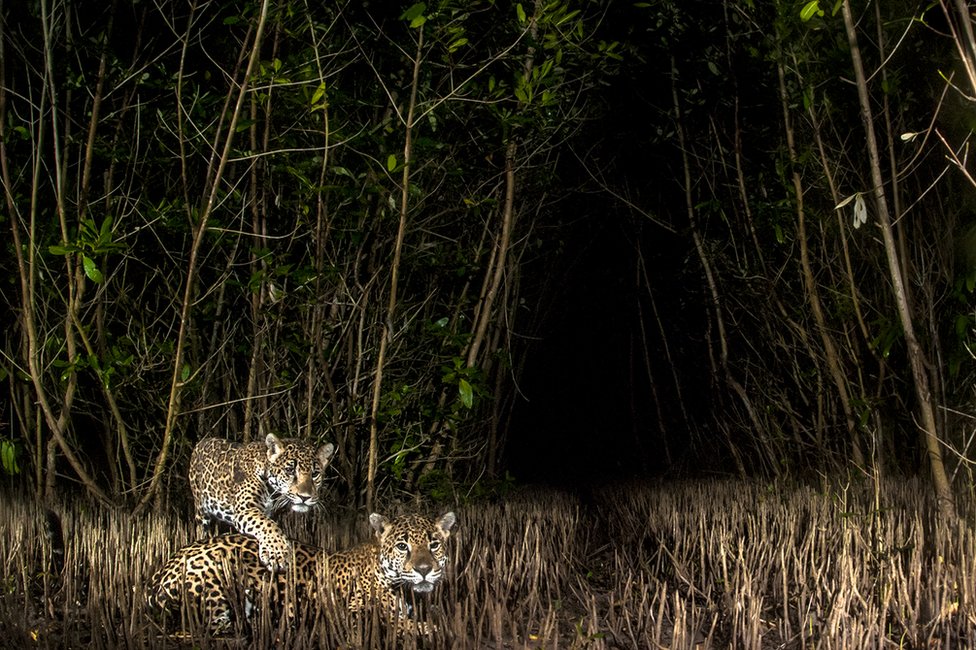Victor Hugo Luja Molina has been named overall winner of this year’s Mangrove Photography Awards, for his image of a female jaguar in an intimate moment with her cub in a mangrove forest in Mexico.


image copyrightVictor Hugo Luja Molina
Run by the Mangrove Action Project, the competition, now in its sixth year, aims to show the relationships between wildlife, coastal communities, and mangrove forests, as well as the fragility of these unique ecosystems, both above and below the waterline.
Luja Molina’s winning image, Once Again Being a Mother, was selected from more than 1,000 entries from nearly 70 countries.
“I love this picture because it shows the mangrove roots, the mangrove forest in detail and at night,” says Luja Molina.
“This is one of the very few photos that exist of jaguars in mangrove ecosystems.
“After two years of failed attempts with the camera trap – blurry images, partial shots and lost cameras – Janis, a female resident mangrove jaguar, finally gave us a great moment with one of her cubs.
“The mangrove ecosystem in western Mexico is facing huge conservation problems, with so much land-use change, including illegal shrimp farms.”
Mangroves are an important protection against climate change, with one acre (4,000 sq m) of mangrove forest absorbing nearly the same amount of carbon dioxide as an acre of Amazon rainforest.
The forests also protect coastlines from eroding as intense storms grow more frequent.
Judge Steve Winter says: “Mangroves are such a vitally important part of the ecosystem, they are the nursery for many aquatic species.
“The health of these ecosystems are vital to human and animal health.”
Here is a selection of winning images from five competition categories, with descriptions by the photographers.
image copyrightJenny Stock
A beautiful and powerful animal, an American crocodile, seen in his home, the mangroves of Jardines de la Reina, Cuba.
This was my first in-water encounter with a crocodile.
And it was completely exhilarating.
Being up close with such a wild and powerful animal would make your heart race.
image copyrightAnita Kainrath
Juvenile lemon sharks in Bimini, Bahamas, using mangrove-fringed lagoons and creeks as nurseries.
image copyrightMorgan Bennett-Smith
Local boys gather in front of a small mangrove-associated outcropping along the coast of Papua New Guinea.
Coastal ecosystems here rely on a community-based system of conservation and protection.
The local people value their ecosystems and protect them.
image copyrightRicci Shryock
A portrait of Ndira and Teresa, of the Bijagos community, in Guinea-Bissau, west Africa, who are part of a women’s group who wade through water among the mangroves during low tide to look for oysters.
The oysters are then sold or sometimes used in traditional ceremonies.
image copyrightHarry Pieters
A unique mangrove sunset scene along Walakiri Beach, in East Sumba, Indonesia, where the trees sway across a stretch of white sand.
image copyrightChris Scarffe
The mangroves and meandering rivers of north-west Madagascar, from the air, in early morning light, with the dramatic volcanic island of Nosy Komba in the background.
image copyrightMatthew D Potenski
I took this split shot of a sand-spit being built across a shallow lagoon.
By the next day, the mangrove shoot pictured was buried under piles of sand fill.
This development had no building permits and is indicative of how projects can move forward and do damage without any legal authority.
This image always seems to elicit a strong emotional reaction in people.
image copyrightVidyasagar Hariharan
The remaining mangroves in Mumbai are under threat.
Here, flamingos are seen feeding in a wetland, with the reflection of buildings – a grim testimony of the struggle and loss of habitat these birds are facing.
image copyrightPratik Chorge
With reduced human activity this year, a record number of flamingos made the journey across to Mumbai, India.
Talawe Wetlands was given an extra pink spectacle, after microscopic algae and bacteria mixed with the rising humidity and turned parts of the water pink.
image copyrightRoshni Lodhia
Rangers on Pate Island, Kenya, are tasked to patrol the mangrove areas for illegal mangrove logging.
image copyrightSoham Bhattacharyya
The tiger is the biggest mystery of mangroves.
Local villagers consider the tigers as “God” because they protect the jungle from any human threat.
image copyrightShane Gross
In 2017, Puerto Rico was hit by hurricanes Irma and Maria, just two weeks apart.
Large swaths of mangroves near Cabo Rojo were killed and have not recovered three years later.
image copyrightVictor Fidelis Sentosa
Youth nowadays need to be more aware of the mangrove ecosystem and its function.
Campaigns and socialisation must also come with actions for a brighter future.
image copyrightSrikanth Mannepuri
Conversion of mangrove forests into commercial aquaculture ponds is the biggest threat to mangroves.
image copyrightRicci Shryock
Sona Sedja, 29, washes the oysters she has collected before taking them to market.
Sedja uses the income to support herself and her two children.
image copyrightAlvaro Herrero Lopez-Beltran
image copyrightJanos Leo G. Andanar
A tourist boat in the middle of the mangrove in Siargao Island, Philippines.
Tourists are not just enjoying surfing the waves of the island but also the vast mangrove forest with clear waters for them to explore.
All pictures copyright.
Read MoreFeedzy
Roofing is a crucial aspect of a building's structure as it protects the interior from…
When it comes to maintaining a home, one of the most important aspects to consider…
Galveston, Texas, is quickly emerging as a premier destination for deep-sea fishing enthusiasts in search…
In the ever-evolving landscape of construction and building maintenance, sustainability has emerged as a crucial…
Minnesota, celebrated for its picturesque rural landscapes and vibrant urban centers such as St. Paul…
In the realm of kitchen renovations, cabinetry plays a pivotal role in shaping both the…